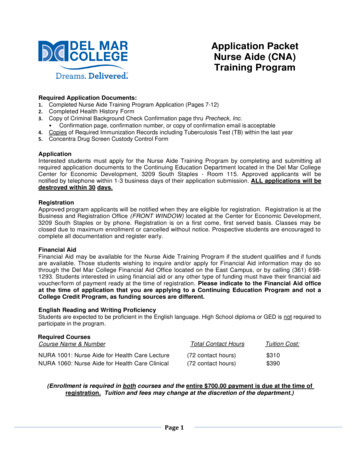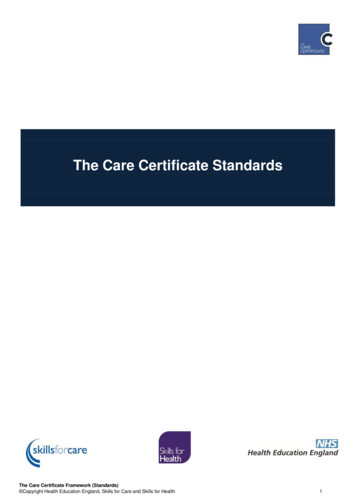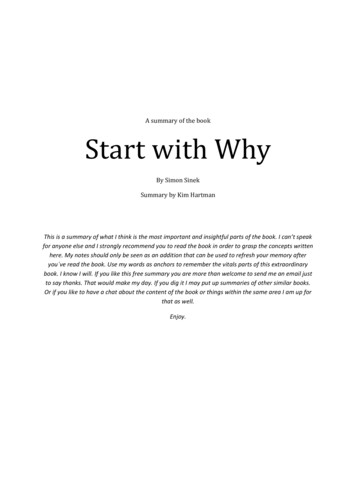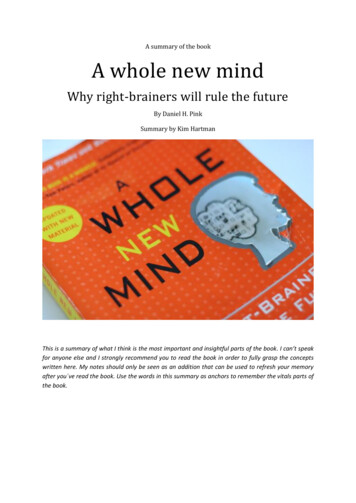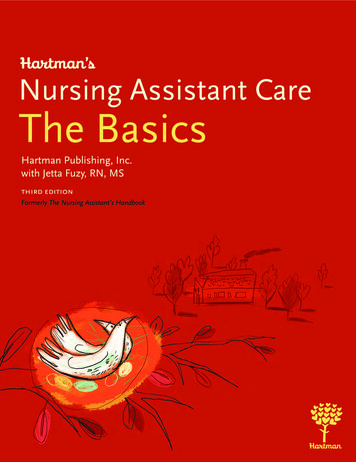
Transcription
Hartman’s Nursing Assistant CareThe BasicsHartman Publishing, Inc.with Jetta Fuzy, RN, MSthird edition
iiCreditsSpecial ThanksManaging EditorSusan Alvare HedmanA heartfelt thank you goes to our insightful and wonderfulreviewers, listed in alphabetical order:DesignerKirsten BrowneGwen C. Brocklehurst, RNCross Hill, SCIllustratorThaddeus CastilloDiane Doiron RN, BSHSATempe, AZCover IllustratorJo TroncMarie Johnston, RNHarrisburg, PAPage LayoutThaddeus CastilloSally Lyle, RN, BSNRock Hill, SCPhotographyArt Clifton/Dick Ruddy/Pat BerrettChristine A. Mettille, RN, MSNSuffolk, VAProofreadersKristin Calderon/Beth NorthcutYolonda Moll, LPNGentry, ARSales/MarketingDebbie Rinker/Caroyl Scott/Kendra Robertson/Erika WalkerWendy Pickard-Tanios RN, BS, ONCRound Rock, TXCustomer ServiceFran Desmond/Tom Noble/Angela Storey/Cheryl GarciaWarehouse CoordinatorCody PinkertCopyright Information 2010 by Hartman Publishing, Inc.8529 Indian School Road, NEAlbuquerque, New Mexico 87112(505) 291-1274web: hartmanonline.come-mail: orders@hartmanonline.comAll rights reserved. No part of this book may be reproduced, in any form or by any means, without permission inwriting from the publisher.ISBN 978-1-60425-014-5PRINTED IN CANADANotice to ReadersThough the guidelines and procedures contained in thistext are based on consultations with healthcare professionals, they should not be considered absolute recommendations. The instructor and readers should follow employer,local, state, and federal guidelines concerning healthcarepractices. These guidelines change, and it is the reader’s responsibility to be aware of these changes and of the policiesand procedures of her or his healthcare facility.The publisher, author, editors, and reviewers cannot acceptany responsibility for errors or omissions or for any consequences from application of the information in this bookand make no warranty, expressed or implied, with respectto the contents of the book. The Publisher does not warrant or guarantee any of the products described herein orperform any analysis in connection with any of the productinformation contained herein.Gloria Stafford, RNAustin, TXJean P. Stanhagen, RN, BSNBethel Park, PAVirginia Vollmer, PhD, RNSignal Mountain, TNMany informative photos came from the following sources: Dr. Jeffrey T. Behr The Briggs Corporation Detecto Dr. Tamara D. Fishman andThe Wound Care Institute, Inc. Harrisburg Area Community College Hollister Incorporated Innovative Products Unlimited Lenjoy Medical Engineering Motion Control, Inc. North Coast Medical, Inc. Dr. Frederick Miller Nova Ortho Med, Inc. Lee Penner of Penner Tubs RG Medical Diagnostics of Southfield, MI Vancare, Inc.Gender UsageThis textbook utilizes the pronouns “he,” “his,” “she,” and“hers” interchangeably to denote healthcare team membersand residents.
iiiContentsPage1 The Nursing Assistant inLong-Term Care1. Compare long-term care to other healthcaresettings12. Describe a typical long-term care facility23. Explain Medicare and Medicaid34. Describe the role of the nursing assistant35. Describe the care team and the chain ofcommand56. Define policies, procedures, and professionalism87. List examples of legal and ethical behavior andexplain Residents’ Rights108. Explain legal aspects of the resident’s medicalrecord179. Explain the Minimum Data Set (MDS)1810. Discuss incident reports192 Foundations of Resident Care1. Understand the importance of verbal andwritten communications202. Describe barriers to communication233. List guidelines for communicating withresidents with special needs254. Identify ways to promote safety and handlenon-medical emergencies295. Demonstrate how to recognize and respondto medical emergencies356. Describe and demonstrate infection preventionpractices43Learning ObjectivePage7. Describe the stages of human development628. Discuss the needs of people withdevelopmental disabilities659. Describe mental illness, depression andrelated care6610. Explain how to care for dying residents6711. Define the goals of a hospice program724 Body Systems and RelatedConditions1. Describe the integumentary system732. Describe the musculoskeletal systemand related conditions753. Describe the nervous system andrelated conditions784. Describe the circulatory system andrelated conditions845. Describe the respiratory system andrelated conditions876. Describe the urinary system andrelated conditions897. Describe the gastrointestinal systemand related conditions918. Describe the endocrine system andrelated conditions949. Describe the reproductive system andrelated conditions9710. Describe the immune and lymphaticsystems and related conditions995 Confusion, Dementia, andAlzheimer’s Disease3 Understanding Your Residents1. Identify basic human needs562. Define “holistic care”583. Explain why promoting independence andself-care is important584. Identify ways to accommodate culturaldifferences595. Describe the need for activity6. Discuss family roles and their significance inhealth care1. Discuss confusion and delirium1042. Describe dementia and discussAlzheimer’s disease1053. List strategies for better communicationwith residents with Alzheimer’s disease106614. List and describe interventions for problemswith common activities of daily living (ADLs)108615. List and describe interventions for commondifficult behaviors related to Alzheimer’s disease111
ivLearning Objective6. Describe creative therapies for residentswith Alzheimer’s diseasePagePage6. Identify ways to promote appetites at mealtime 2061156 Personal Care Skills1. Explain personal care of residentsLearning Objective1172. Identify guidelines for providing skin careand preventing pressure sores1183. Describe guidelines for assisting with bathing1217. Demonstrate how to assist with eating2078. Identify signs and symptoms ofswallowing problems2109. Describe how to assist residents withspecial needs2124. Describe guidelines for assisting with grooming 1309 Rehabilitation and RestorativeCare5. List guidelines for assisting with dressing1351. Discuss rehabilitation and restorative care2146. Identify guidelines for proper oral hygiene1387. Explain guidelines for assisting with toileting1432. Describe the importance of promotingindependence and list ways exercise improveshealth2158. Explain the guidelines for safely positioningand moving residents1473. Discuss ambulation and describe assistivedevices and equipment2154. Explain guidelines for maintaining properbody alignment2195. Describe care guidelines for prosthetic devices2206. Describe how to assist with range of motionexercises2217. List guidelines for assisting with bowel andbladder retraining2257 Basic Nursing Skills1. Explain admission, transfer, and dischargeof a resident1602. Explain the importance of monitoring vital signs 1643. Explain how to measure weight and height1774. Explain restraints and how to promote arestraint-free environment1795. Define fluid balance and explain intake andoutput (I&O)1826. Explain care guidelines for different typesof tubing1867. Discuss a resident’s unit and related care19010 Caring for Yourself1. Describe how to find a job2272. Describe a standard job description2293. Discuss how to manage and resolve conflict2294. Describe employee evaluations anddiscuss appropriate responses to criticism2305. Discuss certification and explain thestate’s registry2316. Describe continuing education2327. Explain ways to manage stress2322. Describe factors that influence food preferences 200Abbreviations2353. Explain special dietsGlossary236Index2478. Explain the importance of sleep andperform proper bedmaking1919. Discuss dressings and bandages1958 Nutrition and Hydration1. Identify the six basic nutrients andexplain MyPyramid1972014. Describe how to assist residents inmaintaining fluid balance2035. List ways to identify and preventunintended weight loss205
vProcedurePageProcedurePageProceduresMoving a resident to the side of the bed149Turning a resident150Performing abdominal thrusts for the consciouspersonLogrolling a resident with one assistant15236Responding to shock37Assisting resident to sit up on side of bed:dangling153Responding to a heart attack38Transferring a resident from bed to wheelchair156Controlling bleeding39Transferring a resident using a mechanical lift158Treating burns39Admitting a resident161Responding to fainting40Transferring a resident162Responding to seizures41Discharging a resident163Responding to vomiting42Measuring and recording oral temperature166Washing hands46Measuring and recording rectal temperature168Putting on (donning) gown48Measuring and recording tympanic temperature169Putting on (donning) mask and goggles48Measuring and recording axillary temperature170Putting on (donning) gloves49Removing (doffing) gloves49Measuring and recording radial pulse andcounting and recording respirations171Caring for an ostomy94Measuring and recording blood pressure(one-step method)173Measuring and recording blood pressure(two-step method)174Measuring and recording weight of anambulatory resident177Measuring and recording height of a resident178Measuring and recording urinary output183Collecting a routine urine specimen184Collecting a clean catch (mid-stream) urinespecimen184Collecting a stool specimen185Providing catheter care187Making an occupied bed192Making an unoccupied bed195Changing a dry dressing using non-steriletechnique195Serving fresh water205Feeding a resident who cannot feed self208Assisting a resident to ambulate215Assisting with ambulation for a resident using acane, walker, or crutches217Assisting with passive range of motion exercises221Giving a complete bed bath122Giving a back rub125Shampooing hair in bed127Giving a shower or a tub bath128Providing fingernail care130Providing foot care131Combing or brushing hair133Shaving a resident134Dressing a resident with an affected (weak)right arm136Putting a knee-high elastic stocking on resident137Providing oral care139Providing oral care for the unconscious resident140Flossing teeth141Cleaning and storing dentures142Assisting resident with use of bedpan144Assisting a male resident with a urinal145Assisting a resident to use a portable commode ortoilet147Moving a resident up in bed148
Using a Hartman Textbook18viUsing aHartmanTextbookUnderstanding how your bookis organized and what its specialfeatures are will help you makethe most of this resource!
vii181. List examples of legal andethical behaviorEverything in this book, the student workbook, andyour instructor’s teaching material is organizedaround learning objectives. A learning objective is avery specific piece of knowledge or a very specific skill.After reading the text, if you can do what the learningobjective says, you know you have mastered thematerial.bloodborne pathogensYou’ll find bold key terms throughout the text followedby their definition. They are also listed in the glossaryat the back of this book.Making an occupied bedGuidelines: Preventing FallsResidents’ RightsAbuse and Alzheimer’s DiseasePeople with Alzheimer’s disease may be at a higherrisk for abuse.All care procedures are highlighted by the same blackbar for easy recognition.Guidelines and Observing and Reporting are coloredgreen for easy reference.These boxes teach important information on how tosupport and promote Residents’ Rights, as well asprovide other types of important information.Using a Hartman TextbookWe have assigned each chapter its own colored tab.Each colored tab contains the chapter number andtitle, and you’ll see them on the side of every page.
1The Nursing Assistant inLong-Term Care1. Compare long-term care to otherhealthcare settingsWelcome to the world of health care. Healthcare happens in many places. Nursing assistantswork in many of these settings. In each settingsimilar tasks will be performed. However, eachsetting is also unique.This textbook will focus on long-term care.Long-term care (LTC) is given in long-term carefacilities (LTCF) for persons who need 24-hoursupervised nursing care. This type of care isgiven to people who need a high level of care forongoing conditions. The term “nursing homes”was once widely used to refer to these facilities.Now, however, they are often called long-termcare facilities, skilled nursing facilities, residential facilities, rehabilitation centers, or extendedcare facilities.People who live in long-term care facilities maybe disabled and/or elderly. They may arrive fromhospitals or other healthcare settings. Theirlength of stay (the number of days a personstays in a care facility) may be short, such asa few days or a few months, or longer than sixmonths. Some of these people will have a terminal illness. This means that the person is expected to die from the illness. Other people mayrecover and return to their homes or to otherfacilities or situations.Most conditions seen in long-term care arechronic. This means they last a long period oftime, even a lifetime. Chronic conditions includephysical disabilities, heart disease, stroke, anddementia. (You will learn more about these disorders and diseases in Chapters 4 and 5.)People who live in long-term care facilities areusually called “residents” because the facility iswhere they reside or live. These places are theirhomes for the duration of their stay.People who need long-term care will have different diagnoses, or medical conditions determined by a doctor. The stages of illnessesor diseases affect how sick people are and howmuch care they will need. The job of nursingassistants will also vary. This is due to each person’s different symptoms, abilities, and needs.Other types of healthcare settings include:Home health care is provided in a person’shome (Fig. 1-1). This type of care is also generally given to people who are older and are chronically ill but who are able to and wish to remainat home. Home care may also be needed when aperson is weak after a recent hospital stay. Homecare includes many of the services offered inother settings.Fig. 1-1. Home care is performed in a person’s home.1The Nursing Assistant in Long-Term Care1
The Nursing Assistant in Long-Term Care12Assisted living facilities provide some helpwith daily care, such as showers, meals, anddressing. Help with medications may also begiven. People who live in these facilities do notneed skilled, 24-hour care. Assisted living facilities allow more independent living in a homelike environment. An assisted living facility maybe attached to a long-term care facility, or it maystand alone.Subacute care can be given in a hospital or ina long-term care facility. Subacute care is givento people who have had an acute injury or illness or problem resulting from a disease. Thesepatients need treatment that requires more carethan some long-term care facilities can give andless care than acute illnesses require. The cost isusually less than a hospital but more than longterm care.Adult daycare is care given at a facility duringdaytime working hours. Generally, adult daycareis for people who need some help but are not seriously ill or disabled. Adult daycare centers givedifferent levels of care. Adult daycare can alsoprovide a break for spouses, family members,and friends.Outpatient care is usually given for less than24 hours. It is for people who have had treatments or surgery and need short-term skilledcare.Acute care is given in hospitals and ambulatory surgical centers. It is for people who havean immediate illness. People are admitted forshort stays for surgery or diseases. Acute care is24-hour skilled care for temporary, but serious,illnesses or injuries (Fig. 1-2). Skilled care ismedically necessary care given by a skilled nurseor therapist. This care is available 24 hours aday. It is ordered by a doctor, and involves atreatment plan.Rehabilitation is care given in facilities orhomes by a specialist. Physical, occupational,and speech therapists restore or improve function after an illness or injury. You will learnmore about rehabilitation and related care inChapter 9.Hospice care is given in facilities or homes forpeople who have six months or less to live. Hospice workers give physical and emotional careand comfort. They also support families. Youwill learn more about hospice care in Chapter 3.2. Describe a typical long-term carefacilityLong-term care facilities (LTCF) are businessesthat provide skilled nursing care 24 hours aday. These facilities may offer assisted livinghousing, dementia care, or subacute care. Somefacilities offer specialized care. Others care forall types of residents. The typical long-term carefacility offers personal care for all residents andfocused care for residents with special needs.Personal care includes bathing, skin, nail andhair care, and assistance with walking, eating,dressing, transferring, and toileting. All of thesedaily personal care tasks are called “activities ofdaily living,” or ADLs. Other common servicesoffered at LTCFs include the following:Fig. 1-2. Acute care is performed in hospitals for illnessesor injuries that require immediate care. Physical, occupational, and speech therapy Wound care
Care of different types of tubes and catheters(a thin tube inserted into the body that isused to drain fluids or inject fluids) Nutrition therapy Management of chronic diseases, such asAIDS, diabetes, chronic obstructive pulmonary disease (COPD), cancer, and congestiveheart failure (CHF)When specialized care is offered at long-termcare facilities, the employees must have specialtraining. Residents with similar needs may beplaced in units together. Non-profit companiesor for-profit companies can own long-term carefacilities.Residents’ RightsCulture ChangeSome long-term care facilities are adopting newermodels of care. These models promote meaningful environments with individualized approaches tocare. Culture change is a term given to the processof transforming services for elders so that they arebased on the values and practices of the personreceiving care. Culture change involves respectingboth elders and those working with them. Core values are choice, dignity, respect, self-determination,and purposeful living. To honor culture change, carefacilities may need to change organization practices, physical environments, and relationships at alllevels. For more information, visit the Pioneer Network’s website at pioneernetwork.net. and The EdenAlternative’s website at edenalt.org.3. Explain Medicare and MedicaidThe Centers for Medicare & Medicaid Services(CMS), formerly the Health Care Finance Administration (HCFA), is a federal agency withinthe U.S. Department of Health and Human Services (Fig. 1-3). CMS runs two national healthcare programs, Medicare and Medicaid. Theyboth help pay for health care and health insurance for millions of Americans. CMS has manyother responsibilities as well.Fig. 1-3. The CMS website’s address is cms.hhs.gov.Medicare is a health insurance program thatwas established in 1965 for people aged 65 orolder. It also covers people of any age with permanent kidney failure or certain disabilities.Medicare has four parts. Part A helps pay forcare in a hospital or skilled nursing facility or forcare from a home health agency or hospice. PartB helps pay for doctor services and other medical services and equipment. Part C allows privatehealth insurance companies to provide Medicarebenefits. Part D helps pay for medications prescribed for treatment. Medicare will only pay forcare it determines to be medically necessary.Medicaid is a medical assistance program forlow-income people. It is funded by both the federal government and each state. Eligibility is determined by income and special circumstances.People must qualify for this program.Medicare and Medicaid pay long-term care facilities a fixed amount for services. This amount isbased on the resident’s needs upon admission.4. Describe the role of the nursingassistantNursing assistants can have many different titles. “Nurse aide,” “certified nurse aide,” “patientcare technician” and “certified nursing assistant” are some examples. This textbook will usethe term “nursing assistant.”1The Nursing Assistant in Long-Term Care3
The Nursing Assistant in Long-Term Care14Nursing assistants (NAs) perform assigned nursing tasks, such as taking a resident’s temperature. Nursing assistants also provide personalcare, such as bathing residents, helping them eatand drink, and helping with hair care (Fig. 1-4).Promoting independence and self-care are othervery important tasks that nursing assistantsdo. Other nursing assistant duties include thefollowing:Nursing assistants spend more time with residents than any other care team member. Theyact as the “eyes and ears” of the team. Observingchanges in a resident’s condition and reportingthese changes is a very important role of theNA. Residents’ care can be revised or updatedas conditions change. Another role of the NA iswriting down important information about theresident (Fig. 1-5). This is called charting.Fig. 1-4. Encouraging residents to drink often will be animportant part of your job. Helping residents with toileting needs Assisting residents to move around safely Keeping residents’ living areas neat andclean Caring for supplies and equipment Helping residents dress Making beds Giving backrubs Helping residents with mouth careNursing assistants are generally not allowed togive medications; nurses are responsible for giving medications. Some states allow nursing assistants to work with medications after receivingspecial training. Examples of other tasks thatnursing assistants are not allowed to do are inserting/removing tubes, changing sterile dressings, and giving tube feedings.Fig. 1-5. Observing carefully and reporting accurately aresome of the most important duties you will have.Nursing assistants are part of a team of healthprofessionals. The team includes doctors,nurses, social workers, therapists, dietitians,and specialists. The resident and resident’sfamily are part of the team. Everyone, including the resident, works closely together to meetgoals. Goals include helping residents to recoverfrom illnesses or to do as much as possible forthemselves.Residents’ RightsResponsibility for ResidentsAll residents are the responsibility of each nursingassistant. You will receive assignments to completetasks, care, and paperwork for specific residents. Ifyou see a resident who needs help, even if he or sheis not on your assignment sheet, provide the neededcare.
5. Describe the care team and the chainof commandResidents will have different needs and problems. Healthcare professionals with differentkinds of education and experience will help carefor them (Fig. 1-6). This group is known as the“care team.” Members of the care team includethe following:Fig. 1-6. The care team is made up of many differenthealthcare professionals.The RN also writes and develops care plans. Acare plan is created for each resident. It helpsthe resident achieve his or her goals. The resident assists with developing the care plan. Thecare plan outlines the steps and tasks the careteam must perform. It states how often thesetasks should be performed and specifies howthey should be carried out.Licensed Practical Nurse (LPN) or Licensed Vocational Nurse (LVN). A licensed practical nurseor licensed vocational nurse is a licensed professional who has completed one to two years ofeducation. An LPN/LVN gives medications andtreatments. LPNs may also supervise nursing assistants’ daily care of residents.Physician or Doctor (MD or DO). A doctor’s jobis to diagnose disease or disability and prescribetreatment. Doctors have graduated from fouryear medical schools after receiving bachelor’sdegrees. Many doctors also take specializedtraining programs after medical school (Fig.1-7). (“DO” stands for “doctor of osteopathicmedicine.”)Nursing Assistant (NA) or Certified Nursing Assistant (CNA). The nursing assistant (NA) performs assigned tasks, such as taking vital signs.NAs also provide routine personal care, suchas bathing residents and helping with toileting.Nursing assistants must have at least 75 hours oftraining, and, in many states, training exceeds100 hours.Registered Nurse (RN). A registered nurse is alicensed professional who has completed two tofour years of education. RNs have diplomas orcollege degrees. They have passed a licensingexam given by the state board of nursing. Registered nurses may have additional academic degrees or education in special areas. In long-termcare, an RN coordinates, manages, and providesskilled nursing care. This includes giving special treatments and medication as prescribed bya doctor. A registered nurse also assigns tasksand supervises daily care of residents by nursingassistants.Fig. 1-7. Doctors diagnose disease and prescribetreatment.1The Nursing Assistant in Long-Term Care5
The Nursing Assistant in Long-Term Care16Physical Therapist (PT). A physical therapistevaluates a person and develops a treatmentplan. Goals are to increase movement, improvecirculation, promote healing, reduce pain, prevent disability, and regain or maintain mobility.A PT gives therapy in the form of heat, cold,massage, ultrasound, electricity, and exercise tomuscles, bones, and joints. For example, a PThelps a person to safely use a walker, cane, orwheelchair (Fig. 1-8). Physical therapist education programs are offered at two degree levels:doctoral and master’s. Entrance into these programs usually requires an undergraduate degree. Master’s degree programs usually last twoyears. Doctoral degree programs last three years.PTs have to pass national and state licensureexams before they can practice.Occupational Therapist (OT). An occupationaltherapist helps residents learn to compensate fordisabilities. An OT helps residents perform activities of daily living (ADLs). This often involvesequipment called assistive or adaptive devices.For example, an OT can teach a person to usea special fork to feed himself. The occupationaltherapist observes a resident’s needs and plansa treatment program. OTs generally have an undergraduate degree before being admitted to adoctoral or master’s program. OTs have to passa national certification examination and mostmust be licensed within their state.Speech-Language Pathologist (SLP). A speechlanguage pathologist helps with speech andswallowing problems. An SLP identifies communication disorders, addresses factors involvedin recovery, and develops a plan of care to meetrecovery goals. An SLP teaches exercises tohelp the resident improve or overcome speechproblems. For example, after a stroke, a personmay not be able to speak or speak clearly. AnSLP may use a picture board to help the personcommunicate thirst or pain. An SLP also evaluates a person’s ability to swallow food and drink.Speech-language pathologists are generally required to have a master’s degree in speech-language pathology. Most states require that SLPsbe licensed or certified to work.Registered Dietitian (RD). A registered dietitiancreates diets for residents with special needs.Special diets can improve health and help manage illness. RDs may supervise the preparation and service of food and educate others onhealthy nutritional habits. Registered dietitianshave completed a bachelor’s degree and may alsohave a master’s degree. They may also have completed postgraduate work. Most states requirethat RDs be licensed or certified.Fig. 1-8. A physical therapist will help restore specificabilities.Medical Social Worker (MSW). A medical socialworker determines residents’ needs and helpsget them support services, such as counseling.
He or she may help residents obtain clothingand personal items if the family is not involvedor does not visit often. A medical social workermay book appointments and transportation.Generally, MSWs hold a master’s degree in social work.Activities Director. The activities director plansactivities for residents to help them socializeand stay active. These activities are meant toimprove and maintain residents’ well-being andto prevent further complications from illness ordisability. An activities director may have a bachelor’s degree, associate’s degree, or qualifyingwork experience. An activities director may becalled a “recreational therapist” depending uponeducation and experience.Resident and Resident’s Family. The residentis an important member of the care team. Theresident has the right to make decisions abouthis or her own care. The resident helps plan careand makes choices. The resident’s family mayalso be involved in these decisions. The familyis a great source of information. They know theresident’s personal preferences, history, diet,rituals, and routines.Residents’ RightsResident as Member of Care TeamAll members of the care team should focus on theresident. The team revolves around the resident andhis or her condition, treatment, and progress. Without the resident, there is no team.As a nursing assistant, you will be carryingout instructions given to you by a nurse. Thenurse is acting on the instructions of a doctoror other member of the care team. This is calledthe chain of command. It describes the line ofauthority and helps to make sure that your residents get proper health care. The chain of command also protects you and your employer fromliability. Liability is a legal term. It means thatsomeone can be held responsible for harmingsomeone else. For example, imagine that something you do for a resident harms him. However,what you did was in the care plan and was doneaccording to policy and procedure. Then youmay not be liable, or responsible, for hurting theresident. However, if you do something not inthe care plan that harms a resident, you couldbe held responsible. That is why it is importantto follow instructions in the care plan and knowthe chain of command (Fig. 1-9).Fig. 1-9. The chain of command describes the line of authority and helps ensure that the resident receives propercare.Nursing assistants must understan
1 The Nursing Assistant in Long-Term Care 1. Compare long-term care to other healthcare settings 1 2. Describe a typical long-term care facility 2 3. Explain Medicare and Medicaid 3 4. Describe the role of the nursing assistant 3 5. Describe the care team and the chain of command 5 6. Define policies, procedures, and professionalism 8 7.

